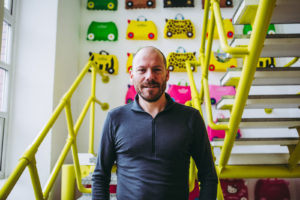Sales & Growth
Article
One size doesn’t fit all: Trunki’s method for identifying export markets

Most companies wait until they’ve conquered the domestic market before targeting export markets. But, when a popular design blog covered Trunki’s launch in 2006, the business found itself inundated with requests from international customers.
Founder Rob Law remembered the “crazy amount of interest” Trunki received in its first week. “I hadn’t even quit my full-time job, but our inbox was full of enquiries from America, Japan and South Africa. Our first customer was The Museum of Modern Art in New York. Then we secured distribution to South Africa and Japan soon after,” he added.
When you’re new to the export market, it can be hard to know how to filter and vet enquiries and potential distributors. It’s something Rob didn’t spend a lot of time on in the early days. However, in the last decade, he’s become adept at assessing opportunities.
Similar values
It’s important to find distribution partners that complement your vision. Rob develops partnerships based on their values, vision and network. The network is particularly important – don’t be tempted to partner with someone who can’t give you the reach you need.
“You’ve got to think fresh for new markets. For that reason, distributors that cover lots of markets aren’t going to be the best,” he said.
Rob recommends looking for distributors that have similar, parallel brands that don’t compete with yours. Trade shows are a great way to make connections, but competitors will often use them to dig into your pricing.
“Find out what a business is going to do for you before disclosing how much things cost. You can weed out time wasters that way: people who aren’t going to be a good partner or people that are interested in copying you,” he said.
Export markets

Trunki is currently exporting to 50 countries, adding Ukraine and Israel to its roster in 2019. The main lesson Rob has learnt is that the biggest export markets aren’t always the easiest to sell in.
The business found it difficult in France and Germany, where distributors were conflicted about whether Trunki fit into the toy, nursery or travel department. Now, Rob’s moved away from distributors in those countries and is focused on supplying the market directly through Trunki’s own channels. On the other hand, there’s been unexpected success in smaller export markets.
“One thing we’ve found is that distributors in smaller markets try harder. Our partners in the Scandinavian nations and Australia will push into so many different channels,” Rob said.
To decide where to focus their efforts, Trunki prioritises countries that have a large number of their target demographic. Rob recommends you then split markets into three tiers: strategic, important and maintenance.
- Strategic: Markets with the biggest opportunity, like China, America, France and Germany. This is where attention is focused
- Important: Markets with a sizeable audience, where there’s future potential
- Maintenance: Smaller export markets with less interest in the product. Less time is spent working with distributors in these markets
Tailored approach
It can be tempting to group export markets together when they share languages or landmass. But Rob urged business owners to treat every market as unique. He gave the example of America – although we share a language, culturally it’s very different to the UK.
“The local preferences change, so don’t assume you can sell the exact same product everywhere,” he said. “We’ve built up a wide range of colours because China likes bright colours whereas Scandinavian countries prefer muted tones. Purple hasn’t sold well in Northern Europe because it’s more of a funeral colour. Remember that one size doesn’t fit all.”
Ultimately, Rob explained, it’s all about taking the time to test and see what works in each market.
“All kids travel and all kids get bored, but that doesn’t mean it’s always an easy route in. When we work with distributors, some relationships form well and some don’t. Each country is different, so you’ve got to figure out the right cords to pull in each market.”